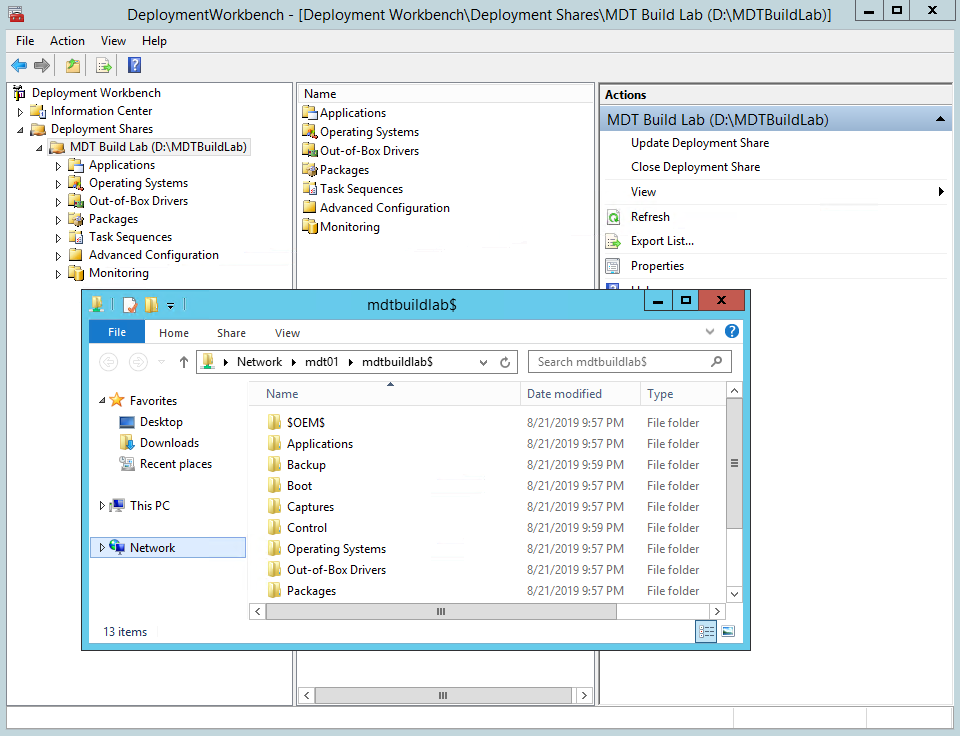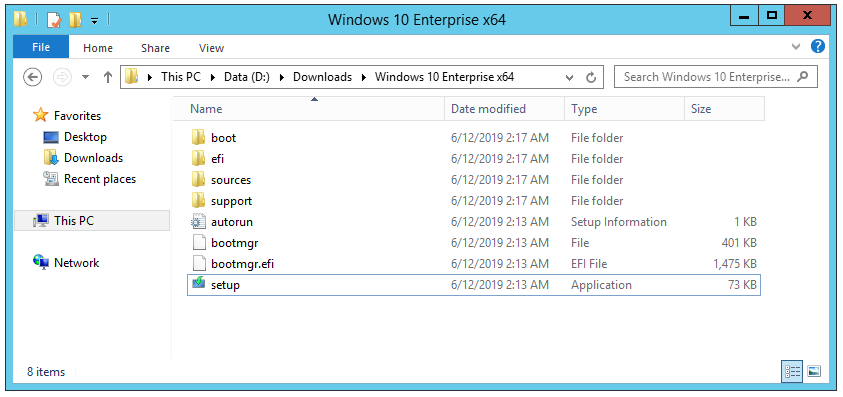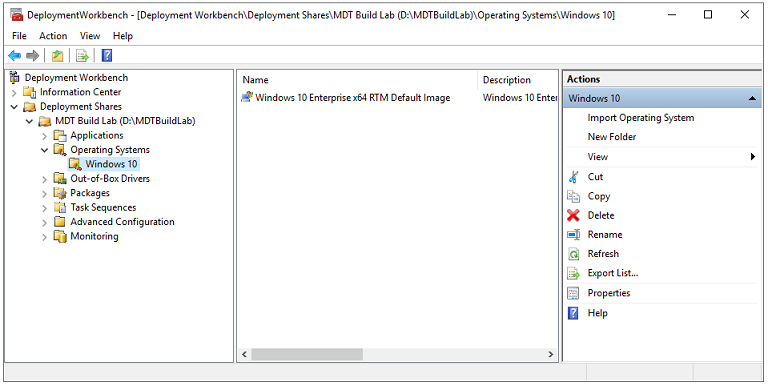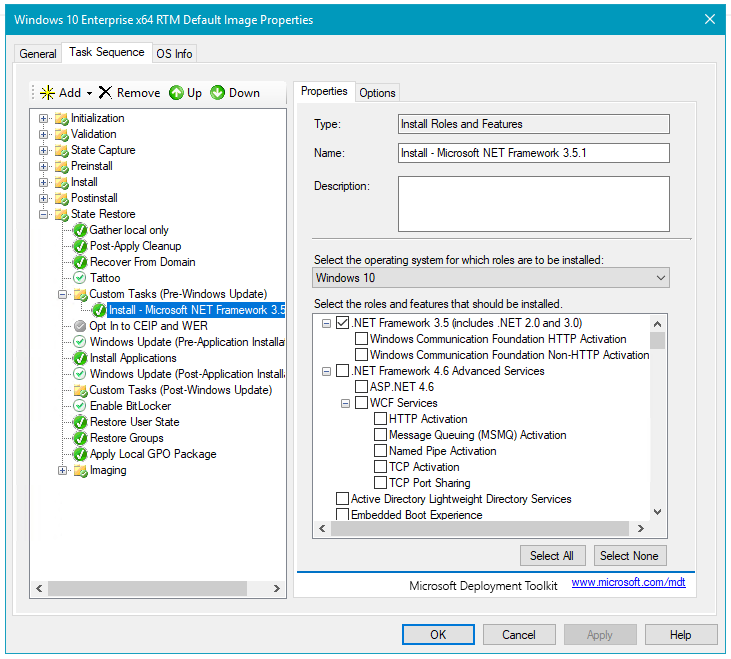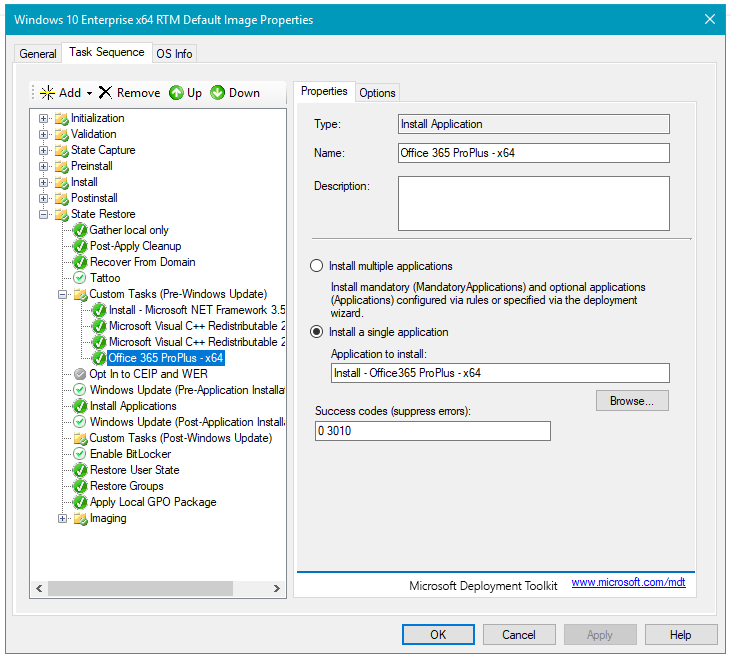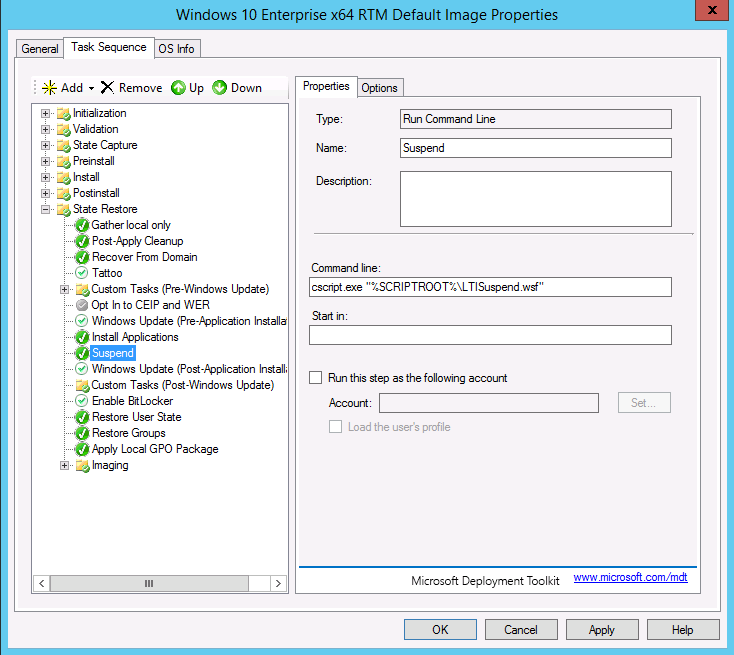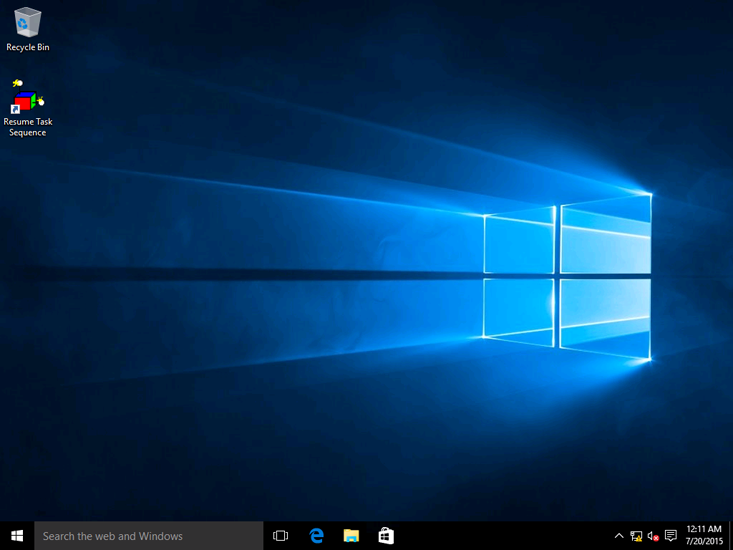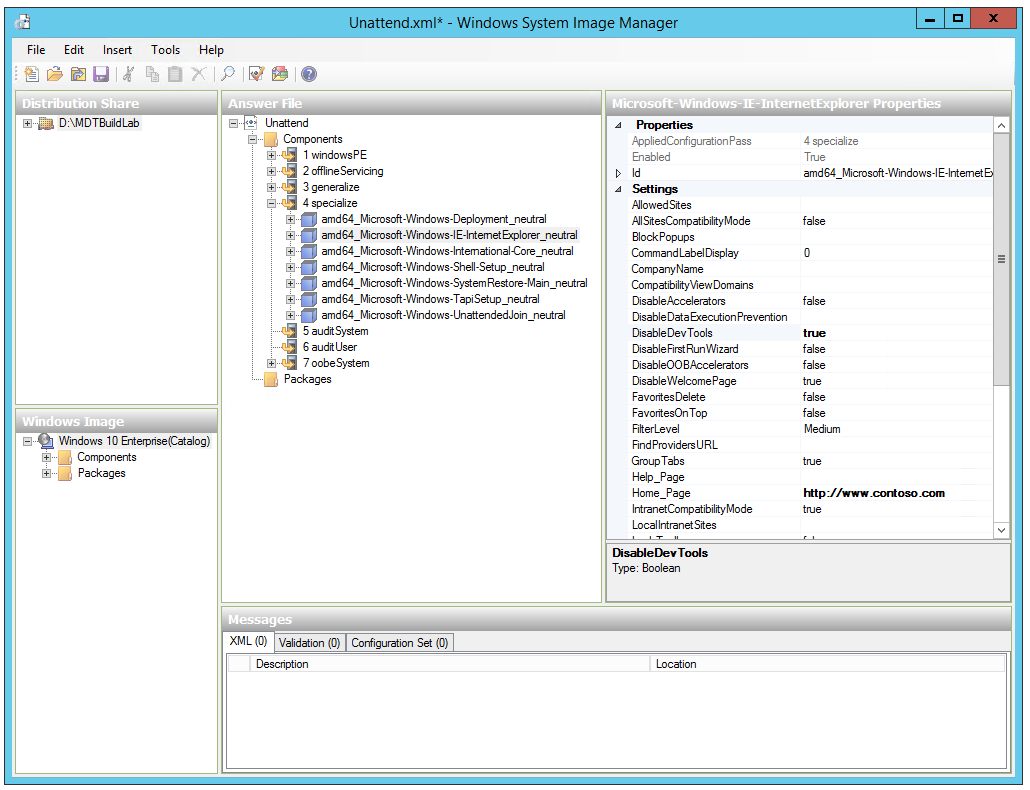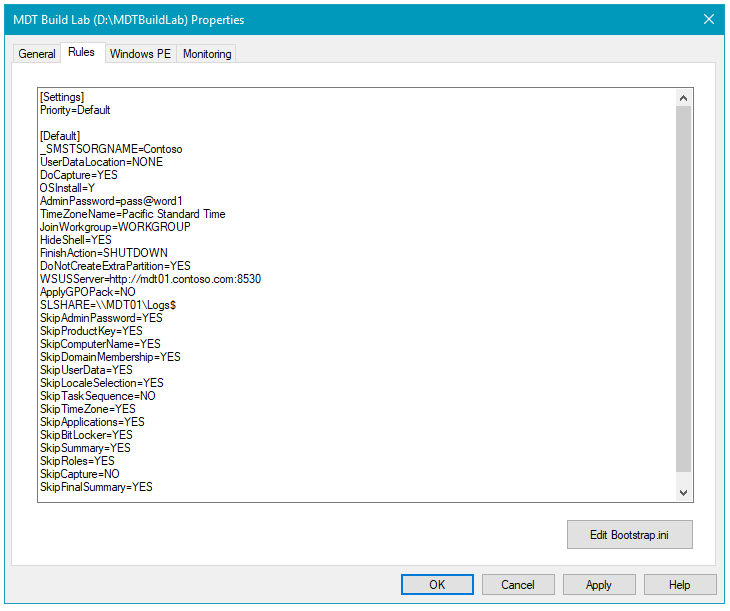- Capture and apply Windows, system, and recovery partitions
- Capture the customized partitions
- Step 1: Determine which partitions to capture
- Step 2: Prepare to capture partitions
- Step 3: Capture images for each customized partition.
- Step 4: Save images to the network or another safe location.
- Apply the images
- Step 1: Prepare to apply partitions
- Step 2: Apply the partitions
- Step 3: Verify that it worked
- Create a Windows 10 reference image
- The reference image
- Set up the MDT build lab deployment share
- Create the MDT build lab deployment share
- Enable monitoring
- Configure permissions for the deployment share
- Add setup files
- Add the WindowsВ 10 installation files
- Add WindowsВ 10 Enterprise x64 (full source)
- Add applications
- Create configuration file: Microsoft Office 365 Professional Plus x64
- Connect to the deployment share using Windows PowerShell
- Create the install: Microsoft Office 365 Pro Plus — x64
- Create the install: Microsoft Visual C++ Redistributable 2019 — x86
- Create the install: Microsoft Visual C++ Redistributable 2019 — x64
- Create the reference image task sequence
- Drivers and the reference image
- Create a task sequence for Windows 10 Enterprise
- Edit the WindowsВ 10 task sequence
- Optional configuration: Add a suspend action
- Edit the Unattend.xml file for WindowsВ 10 Enterprise
- Configure the MDT deployment share rules
- MDT deployment share rules overview
- Update the deployment share
- The rules explained
- The Bootstrap.ini file
- The CustomSettings.ini file
- Build the Windows 10 reference image
- Troubleshooting
Capture and apply Windows, system, and recovery partitions
When you’re deploying Windows using the WIM format, and using customized partitions, a customized system partition or an additional utility partition, learn how to capture the right partitions to apply to new PCs.
If you don’t need custom partitions, you usually can just capture the Windows partition, and then use files from that image to set up the rest of the partitions on the drive. See Capture and Apply Windows using a single WIM file.
If you’re capturing using the FFU format, you’ll be fine — FFU captures all of the partitions on the drive.
Capture the customized partitions
Step 1: Determine which partitions to capture
This table shows the types of partitions that you must capture and those that are managed automatically.
If you’re deploying both UEFI and BIOS systems, you can reuse your primary and logical partitions across UEFI-based and BIOS-based devices, but not the other partition types.
| Partition type | Should you capture this partition? | Can you reuse the same WIM on UEFI and BIOS firmware? |
|---|---|---|
| System partition (EFI System Partition or BIOS system partition) | Optional. If only a simple set of partition files is required, you don’t have to capture this partition. | No |
| Microsoft Reserved partition (MSR) | No | No |
| Primary partitions (Windows partitions, data / utility partitions that you’ve added) | Yes | Yes |
| Recovery partition | Optional. If you haven’t customized this partition, you don’t have to capture it. | No |
| Extended partition | No | No |
| Logical partitions (Windows partitions, data / utility partitions that you’ve added) | Yes | Yes |
Step 2: Prepare to capture partitions
If you’ve booted the Windows image, generalize it so that it can be deployed to other devices. For more information, see Sysprep (Generalize) a Windows installation.
Start your reference device by using WindowsВ PE.
At the WindowsВ PE command prompt, type diskpart to open the DiskPart tool.
Check to see if the partitions that you want to capture have drive letters assigned.
If any of the partitions you want to capture don’t already have a drive letter assigned, continue:
List the disks in your PC:
Select the primary hard disk:
View the partitions:
Select a partition that needs a drive letter:
Assign a letter to the partition with the assign letter command. For example,
Type exit to return to the WindowsВ PE command prompt.
For more information, see the DiskPart Help from the command line, or Diskpart Command line syntax.
Step 3: Capture images for each customized partition.
At the WindowsВ PE command prompt, capture each customized partition, for example:
For more information about using the DISM tool to capture an image, see DISM Image Management Command-Line Options.
Step 4: Save images to the network or another safe location.
Connect an external drive, or connect to a safe network location, for example:
If prompted, provide your network credentials.
Copy the partitions to your network share. For example,
Apply the images
Step 1: Prepare to apply partitions
Start your destination device by using WindowsВ PE.
Connect an external drive, or connect to a safe network location, for example:
If prompted, provide your network credentials.
Wipe the hard drive and create new partitions.
To apply to multiple devices, save the Diskpart commands into a script and run them on each new device. For examples, see Configure UEFI/GPT-Based Hard Drive Partitions or Configure BIOS/MBR-Based Hard Drive Partitions. Example:
Where D: is a USB flash drive or other file storage location.
In these DiskPart examples, the partitions are assigned the letters: System=S, Windows=W, and Recovery=R.
Change the Windows drive letter to a letter that’s near the end of the alphabet, such as W, to avoid drive letter conflicts. Do not use X, because this drive letter is reserved for Windows PE. After the device reboots, the Windows partition is assigned the letter C, and the other partitions don’t receive drive letters.
If you reboot, WindowsВ PE reassigns disk letters alphabetically, starting with the letter C, without regard to the configuration in Windows Setup. This configuration can change based on the presence of different drives, such as USB flash drives.
Optional: speed up the image capture by setting the power scheme to High performance:
Step 2: Apply the partitions
Windows and data partitions: Apply the image(s), example:
where W: is the Windows partition.
System partition: You can either:
Configure the system partition by using the BCDBoot tool. This tool copies and configures system partition files by using files from the Windows partition. For example:
Apply a custom image
Where S: is the system partition
Recovery partition:
a. You can either:
Copy the Windows Recovery Environment (RE) tools into the recovery tools partition.
Where R: is the recovery partition
Apply a custom image
b. Register the location of the recovery tools, and hide the recovery partition using Diskpart. You can use our sample script or perform the steps manually:
Diskpart steps for UEFI:
Diskpart steps for BIOS:
Step 3: Verify that it worked
Reboot the device ( exit ). Windows should boot.
If the device doesn’t boot, (for example, if you receive the error message: Bootmgr not found. Press CTRL+ALT+DEL) check the steps for setting up the system partition:
- See BCDBoot command-line options for more info about copying boot files to the system partition.
- Use the DiskPart tool to check to make sure that the system partition is set to Active.
Complete the out of box experience (OOBE) as a new user, and check the recovery partition:
Check that in File Explorer that the Recovery partition is not visible.
View the partitions exist, either by right-clicking Start and selecting Disk Management, or by using diskpart (Open a command prompt as an administrator > diskpart > select disk 0 > list partition > exit ).
Create a Windows 10 reference image
Applies to
Creating a reference image is important because that image serves as the foundation for the devices in your organization. In this topic, you will learn how to create a WindowsВ 10 reference image using the Microsoft Deployment Toolkit (MDT). You will create a deployment share, configure rules and settings, and import all the applications and operating system files required to build a WindowsВ 10 reference image. After completing the steps outlined in this topic, you will have a WindowsВ 10 reference image that can be used in your deployment solution.
See Prepare for deployment with MDT for more information about the server, client, and network infrastructure used in this guide.
For the purposes of this topic, we will use three computers: DC01, MDT01, and HV01.
- DC01 is a domain controller for the contoso.com domain.
- MDT01 is a contoso.com domain member server.
- HV01 is a Hyper-V server that will be used to build the reference image.
Computers used in this topic.
The reference image
The reference image described in this guide is designed primarily for deployment to physical devices. However, the reference image is typically created on a virtual platform, before being automatically run through the System Preparation (Sysprep) tool process and captured to a Windows Imaging (WIM) file. The reasons for creating the reference image on a virtual platform are the following:
- To reduce development time and can use snapshots to test different configurations quickly.
- To rule out hardware issues. You simply get the best possible image, and if you have a problem, it’s not likely to be hardware related.
- To ensures that you won’t have unwanted applications that could be installed as part of a driver install but not removed by the Sysprep process.
- The image is easy to move between lab, test, and production.
Set up the MDT build lab deployment share
With WindowsВ 10, there is no hard requirement to create reference images. However, to reduce the time needed for deployment, you might want to create a reference image that contains a few base applications as well as all of the latest updates. This section will show you how to create and configure the MDT Build Lab deployment share to create a WindowsВ 10 reference image. Because reference images will be deployed only to virtual machines during the creation process and have specific settings (rules), you should always create a separate deployment share specifically for this process.
Create the MDT build lab deployment share
On MDT01:
Sign in as contoso\administrator using a password of pass@word1 (credentials from the prepare for deployment topic).
Start the MDT deployment workbench, and pin this to the taskbar for easy access.
Using the Deployment Workbench, right-click Deployment Shares and select New Deployment Share.
Use the following settings for the New Deployment Share Wizard:
- Deployment share path: D:\MDTBuildLab
- Share name: MDTBuildLab$
- Deployment share description: MDT Build Lab
Accept the default selections on the Options page and click Next.
Review the Summary page, click Next, wait for the deployment share to be created, then click Finish.
Verify that you can access the \\MDT01\MDTBuildLab$ share.
The Deployment Workbench with the MDT Build Lab deployment share.
Enable monitoring
To monitor the task sequence as it happens, right-click the MDT Build Lab deployment share, click Properties, click the Monitoring tab, and select Enable monitoring for this deployment share. This step is optional.
Configure permissions for the deployment share
In order to read files in the deployment share and write the reference image back to it, you need to assign NTSF and SMB permissions to the MDT Build Account (MDT_BA) for the D:\MDTBuildLab folder
On MDT01:
Ensure you are signed in as contoso\administrator.
Modify the NTFS permissions for the D:\MDTBuildLab folder by running the following command in an elevated Windows PowerShell prompt:
Add setup files
This section will show you how to populate the MDT deployment share with the WindowsВ 10 operating system source files, commonly referred to as setup files, which will be used to create a reference image. Setup files are used during the reference image creation process and are the foundation for the reference image.
Add the WindowsВ 10 installation files
MDT supports adding both full source WindowsВ 10 DVDs (ISOs) and custom images that you have created. In this case, you create a reference image, so you add the full source setup files from Microsoft.
Due to the Windows limits on path length, we are purposely keeping the operating system destination directory short, using the folder name W10EX64RTM rather than a more descriptive name like WindowsВ 10 Enterprise x64 RTM.
Add WindowsВ 10 Enterprise x64 (full source)
On MDT01:
Sign in as contoso\administrator and copy the content of a WindowsВ 10 Enterprise x64 DVD/ISO to the D:\Downloads\Windows 10 Enterprise x64 folder on MDT01, or just insert the DVD or mount an ISO on MDT01. The following example shows the files copied to the D:\Downloads folder, but you can also choose to import the OS directly from an ISO or DVD.
Using the Deployment Workbench, expand the Deployment Shares node, and then expand MDT Build Lab.
Right-click the Operating Systems node, and create a new folder named Windows 10.
Expand the Operating Systems node, right-click the Windows 10 folder, and select Import Operating System. Use the following settings for the Import Operating System Wizard:
- Full set of source files
- Source directory: (location of your source files)
- Destination directory name: W10EX64RTM
After adding the operating system, in the Operating Systems / Windows 10 folder, double-click it and change the name to: Windows 10 Enterprise x64 RTM Default Image. See the following example.
Depending on the DVD you used, there might be multiple editions available. For the purposes of this guide, we are using the Windows 10 Enterprise image, but other images will also work.
Add applications
Before you create an MDT task sequence, you need to add any applications and scripts you wish to install to the MDT Build Lab share.
On MDT01:
First, create an MDT folder to store the Microsoft applications that will be installed:
- In the MDT Deployment Workbench, expand Deployment Shares \ MDT Build Lab \ Applications
- Right-click Applications and then click New Folder.
- Under Folder name, type Microsoft.
- Click Next twice, and then click Finish.
The steps in this section use a strict naming standard for your MDT applications.
- Use the «Install — » prefix for typical application installations that run a setup installer of some kind,
- Use the «Configure — » prefix when an application configures a setting in the operating system.
- You also add an » — x86«, » — x64«, or «— x86-x64» suffix to indicate the application’s architecture (some applications have installers for both architectures).
Using a script naming standard is always recommended when using MDT as it helps maintain order and consistency.
By storing configuration items as MDT applications, it is easy to move these objects between various solutions, or between test and production environments.
In example sections, you will add the following applications:
- Install — Microsoft Office 365 Pro Plus — x64
- Install — Microsoft Visual C++ Redistributable 2019 — x86
- Install — Microsoft Visual C++ Redistributable 2019 — x64
The 64-bit version of Microsoft Office 365 Pro Plus is recommended unless you need legacy app support. For more information, see Choose between the 64-bit or 32-bit version of Office
Download all three items in this list to the D:\Downloads folder on MDT01.
Note: For the purposes of this lab, we will leave the MSVC files in the D:\Downloads folder and the Office365 files will be extracted to a child folder. If you prefer, you can place each application in its own separate child folder and then modify the $ApplicationSourcePath below as needed (instead of just D:\Downloads).
All the Microsoft Visual C++ downloads can be found on The latest supported Visual C++ downloads. Visual C++ 2015, 2017 and 2019 all share the same redistributable files.
Create configuration file: Microsoft Office 365 Professional Plus x64
After downloading the most current version of the Office Deployment tool from the Microsoft Download Center using the link provided above, run the self-extracting executable file and extract the files to D:\Downloads\Office365. The Office Deployment Tool (setup.exe) and several sample configuration.xml files will be extracted.
Using a text editor (such as Notepad), create an XML file in the D:\Downloads\Office365 directory with the installation settings for Microsoft 365 Apps for enterprise that are appropriate for your organization. The file uses an XML format, so the file you create must have an extension of .xml but the file can have any filename.
For example, you can use the following configuration.xml file, which provides these configuration settings:
- Install the 64-bit version of Microsoft 365 Apps for enterprise in English directly from the Office Content Delivery Network (CDN) on the internet. Note: 64-bit is now the default and recommended edition.
- Use the Semi-Annual Channel and get updates directly from the Office CDN on the internet.
- Perform a silent installation. You won’t see anything that shows the progress of the installation and you won’t see any error messages.
By using these settings, any time you build the reference image you’ll be installing the most up-to-date Semi-Annual Channel version of Microsoft 365 Apps for enterprise.
You can also use the web-based interface of the Office Customization Tool to help you create your configuration.xml file.
Ensure the configuration.xml file is in the D:\Downloads\Office365 folder. See the following example of the extracted files plus the configuration.xml file in the Downloads\Office365 folder:
Assuming you have named the file «configuration.xml» as shown above, we will use the command «setup.exe /configure configuration.xml» when we create the application in MDT. This will perform the installation of Microsoft 365 Apps for enterprise using the configuration settings in the configuration.xml file. Do not perform this step yet.
After Microsoft 365 Apps for enterprise is installed on the reference image, do NOT open any Office programs. if you open an Office program, you are prompted to sign-in, which activates the installation of Microsoft 365 Apps for enterprise. Even if you don’t sign in and you close the Sign in to set up Office dialog box, a temporary product key is installed. You don’t want any kind of product key for Microsoft 365 Apps for enterprise installed as part of your reference image.
Microsoft 365 Apps for enterprise is usually updated on a monthly basis with security updates and other quality updates (bug fixes), and possibly new features (depending on which update channel you’re using). That means that once you’ve deployed your reference image, Microsoft 365 Apps for enterprise will most likely need to download and install the latest updates that have been released since you created your reference image.
Note: By using installing Office Deployment Tool as part of the reference image, Microsoft 365 Apps for enterprise is installed immediately after the reference image is deployed to the user’s device, rather than including Office apps part of the reference image. This way the user will have the most up-to-date version of Microsoft 365 Apps for enterprise right away and won’t have to download any new updates (which is most likely what would happen if Microsoft 365 Apps for enterprise was installed as part of the reference image.)
When you are creating your reference image, instead of installing Microsoft 365 Apps for enterprise directly from the Office CDN on the internet, you can install Microsoft 365 Apps for enterprise from a location on your local network, such as a file share. To do that, you would use the Office Deployment Tool in /download mode to download the installation files to that file share. Then you could use the Office Deployment Tool in /configure mode to install Microsoft 365 Apps for enterprise from that location on to your reference image. As part of that, you’ll need to point to that location in your configuration.xml file so that the Office Deployment Tool knows where to get the Microsoft 365 Apps for enterprise files. If you decide to do this, the next time you create a new reference image, you’ll want to be sure to use the Office Deployment Tool to download the most up-to-date installation files for Microsoft 365 Apps for enterprise to that location on your internal network. That way your new reference image will have a more up-to-date installation of Microsoft 365 Apps for enterprise.
Connect to the deployment share using Windows PowerShell
If you need to add many applications, you can take advantage of the PowerShell support that MDT has. To start using PowerShell against the deployment share, you must first load the MDT PowerShell snap-in and then make the deployment share a PowerShell drive (PSDrive).
On MDT01:
Ensure you are signed in as contoso\Administrator.
Import the snap-in and create the PSDrive by running the following commands in an elevated PowerShell prompt:
Use «Get-Command -module MicrosoftDeploymentToolkit» to see a list of available cmdlets
Create the install: Microsoft Office 365 Pro Plus — x64
In these steps we assume that you have downloaded the Office Deployment Tool. You might need to modify the path to the source folder to reflect your current environment. In this example, the source path is set to D:\Downloads\Office365.
On MDT01:
Ensure you are signed on as contoso\Administrator.
Create the application by running the following commands in an elevated PowerShell prompt:
Upon successful installation the following text is displayed:
Create the install: Microsoft Visual C++ Redistributable 2019 — x86
We have abbreviated «Microsoft Visual C++ Redistributable» in the $ApplicationName below as «MSVC» to avoid the path name exceeding the maxiumum allowed length of 248 characters.
In these steps we assume that you have downloaded Microsoft Visual C++ Redistributable 2019 — x86. You might need to modify the path to the source folder to reflect your current environment. In this example, the source path is set to D:\Downloads.
On MDT01:
Ensure you are signed on as contoso\Administrator.
Create the application by running the following commands in an elevated PowerShell prompt:
Upon successful installation the following text is displayed:
Create the install: Microsoft Visual C++ Redistributable 2019 — x64
In these steps we assume that you have downloaded Microsoft Visual C++ Redistributable 2019 — x64. You might need to modify the path to the source folder to reflect your current environment. In this example, the source path is set to D:\Downloads.
On MDT01:
Ensure you are signed on as contoso\Administrator.
Create the application by running the following commands in an elevated PowerShell prompt:
Create the reference image task sequence
In order to build and capture your WindowsВ 10 reference image for deployment using MDT, you will create a task sequence. The task sequence will reference the operating system and applications that you previously imported into the MDT Build Lab deployment share to build a WindowsВ 10 reference image. After creating the task sequence, you configure it to enable patching against the Windows Server Update Services (WSUS) server. The Task Sequence Windows Update action supports getting updates directly from Microsoft Update, but you get more stable patching if you use a local WSUS server. WSUS also allows for an easy process of approving the patches that you are deploying.
Drivers and the reference image
Because we use modern virtual platforms for creating our reference images, we don’t need to worry about drivers when creating reference images for Windows 10. We use Hyper-V in our environment, and Windows Preinstallation Environment (Windows PE) already has all the needed drivers built-in for Hyper-V.
Create a task sequence for Windows 10 Enterprise
To create a WindowsВ 10 reference image task sequence, the process is as follows:
On MDT01:
- Using the Deployment Workbench, under Deployment Shares > MDT Build Lab right-click Task Sequences, and create a New Folder named Windows 10.
- Right-click the new Windows 10 folder and select New Task Sequence. Use the following settings for the New Task Sequence Wizard:
- Task sequence ID: REFW10X64-001
- Task sequence name: Windows 10 Enterprise x64 RTM Default Image
- Task sequence comments: Reference Build
- Template: Standard Client Task Sequence
- Select OS: Windows 10 Enterprise x64 RTM Default Image
- Specify Product Key: Do not specify a product key at this time
- Full Name: Contoso
- Organization: Contoso
- Internet Explorer home page: http://www.contoso.com
- Admin Password: Do not specify an Administrator Password at this time
Edit the WindowsВ 10 task sequence
The steps below walk you through the process of editing the WindowsВ 10 reference image task sequence to include the actions required to update the reference image with the latest updates from WSUS, install roles and features, and utilities, and install Microsoft Office365 ProPlus x64.
On MDT01:
- In the Task Sequences / WindowsВ 10 folder, right-click the WindowsВ 10 Enterprise x64 RTM Default Image task sequence, and select Properties.
- On the Task Sequence tab, configure the WindowsВ 10 Enterprise x64 RTM Default Image task sequence with the following settings:
State Restore > Windows Update (Pre-Application Installation) action: Enable this action by clicking the Options tab and clearing the Disable this step check box.
State Restore > Windows Update (Post-Application Installation) action: Also enable this action.
State Restore: After the Tattoo action, add a new Group action (click Add then click New Group) with the following setting:
- Name: Custom Tasks (Pre-Windows Update)
State Restore: After Windows Update (Post-Application Installation) action, rename Custom Tasks to Custom Tasks (Post-Windows Update).
- Note: The reason for adding the applications after the Tattoo action but before running Windows Update is simply to save time during the deployment. This way we can add all applications that will upgrade some of the built-in components and avoid unnecessary updating.
State Restore > Custom Tasks (Pre-Windows Update): Add a new Install Roles and Features action with the following settings:
- Name: Install — Microsoft NET Framework 3.5.1
- Select the operating system for which roles are to be installed: Windows 10
- Select the roles and features that should be installed: .NET Framework 3.5 (includes .NET 2.0 and 3.0)
This is probably the most important step when creating a reference image. Many applications need the .NET Framework, and we strongly recommend having it available in the image. The one thing that makes this different from other components is that .NET Framework 3.5.1 is not included in the WIM file. It is installed from the Sources\SxS folder on the media, and that makes it more difficult to add after the image has been deployed.
The task sequence after creating the Custom Tasks (Pre-Windows Update) group and adding the Install — Microsoft NET Framework 3.5.1 action.
State Restore > Custom Tasks (Pre-Windows Update): After the Install — Microsoft NET Framework 3.5.1 action, add a new Install Application action (selected from the General group) with the following settings:
- Name: Microsoft Visual C++ Redistributable 2019 — x86
- Install a Single Application: browse to Install — MSVC 2019 — x86
Repeat these steps (add a new Install Application) to add Microsoft Visual C++ Redistributable 2019 — x64 and Microsoft 365 Apps for enterprise as well.
Optional configuration: Add a suspend action
The goal when creating a reference image is of course to automate everything. But sometimes you have a special configuration or application setup that is too time-consuming to automate. If you need to do some manual configuration, you can add a little-known feature called Lite Touch Installation (LTI) Suspend. If you add the LTISuspend.wsf script as a custom action in the task sequence, it will suspend the task sequence until you click the Resume Task Sequence shortcut icon on the desktop. In addition to using the LTI Suspend feature for manual configuration or installation, you can also use it simply for verifying a reference image before you allow the task sequence to continue and use Sysprep and capture the virtual machine.
A task sequence with optional Suspend action (LTISuspend.wsf) added.
The Windows 10 desktop with the Resume Task Sequence shortcut.
Edit the Unattend.xml file for WindowsВ 10 Enterprise
When using MDT, you don’t need to edit the Unattend.xml file very often because most configurations are taken care of by MDT. However if, for example, you want to configure Internet ExplorerВ behavior, then you can edit the Unattend.xml for this. Editing the Unattend.xml for basic Internet Explorer settings is easy, but for more advanced settings, you will want to use the Internet Explorer Administration Kit (IEAK).
Do not use SkipMachineOOBE or SkipUserOOBE in your Unattend.xml file. These settings are deprecated and can have unintended effects if used.
You also can use the Unattend.xml to enable components in WindowsВ 10, like the Telnet Client or Hyper-V client. Normally we prefer to do this via the Install Roles and Features action, or using Deployment Image Servicing and Management (DISM) command-line tools, because then we can add that as an application, being dynamic, having conditions, and so forth. Also, if you are adding packages via Unattend.xml, it is version specific, so Unattend.xml must match the exact version of the operating system you are servicing.
Follow these steps to configure Internet Explorer settings in Unattend.xml for the WindowsВ 10 Enterprise x64 RTM Default Image task sequence:
On MDT01:
- Using the Deployment Workbench, under Deployment Shares > MDT Build Lab > Task Sequences right-click the Windows 10 Enterprise x64 RTM Default Image task sequence and select Properties.
- In the OS Info tab, click Edit Unattend.xml. MDT now generates a catalog file. This will take a few minutes, and then Windows System Image Manager (Windows SIM) will start.
The ADK version 1903 has a known issue generating a catalog file for Windows 10, version 1903 or 1909 X64 install.wim. You might see the error «Could not load file or assembly» in in the console output. To avoid this issue, install the ADK, version 2004 or a later version. A workaround is also available for the ADK version 1903:
- Close the Deployment Workbench and install the WSIM 1903 update. This will update imagecat.exe and imgmgr.exe to version 10.0.18362.144.
- Manually run imgmgr.exe (C:\Program Files (x86)\Windows Kits\10\Assessment and Deployment Kit\Deployment Tools\WSIM\imgmgr.exe).
- Generate a catalog (Tools/Create Catalog) for the selected install.wim (ex: D:\MDTBuildLab\Operating Systems\W10EX64RTM\sources\install.wim).
- After manually creating the catalog file (ex: D:\MDTBuildLab\Operating Systems\W10EX64RTM\sources\install_Windows 10 Enterprise.clg), open the Deployment Workbench and proceed to edit unattend.xml.
- In Windows SIM, expand the 4 specialize node in the Answer File pane and select the amd64_Microsoft-Windows-IE-InternetExplorer_neutral entry.
- In the amd64_Microsoft-Windows-IE-InternetExplorer_neutral properties window (right-hand window), set the following values:
- DisableDevTools: true
-
Save the Unattend.xml file, and close Windows SIM.
- Note: If errors are reported that certain display values are incorrect, you can ignore this or browse to 7oobeSystem\amd64_Microsoft-Windows-Shell-Setup__neutral\Display and enter the following: ColorDepth 32, HorizontalResolution 1, RefreshRate 60, VerticalResolution 1.
On the WindowsВ 10 Enterprise x64 RTM Default Image Properties, click OK.
Windows System Image Manager with the Windows 10 Unattend.xml.
Configure the MDT deployment share rules
Understanding rules is critical to successfully using MDT. Rules are configured using the Rules tab of the deployment share’s properties. The Rules tab is essentially a shortcut to edit the CustomSettings.ini file that exists in the D:\MDTBuildLab\Control folder. This section discusses how to configure the MDT deployment share rules as part of your Windows 10 Enterprise deployment.
MDT deployment share rules overview
In MDT, there are always two rule files: the CustomSettings.ini file and the Bootstrap.ini file. You can add almost any rule to either. However, the Bootstrap.ini file is copied from the Control folder to the boot image, so the boot image needs to be updated every time you change that file. For this reason, add only a minimal set of rules to Bootstrap.ini, such as which deployment server and share to connect to — the DEPLOYROOT value. Put the other rules in CustomSettings.ini because that file is updated immediately when you click OK.
To configure the rules for the MDT Build Lab deployment share:
On MDT01:
Using the Deployment Workbench, right-click the MDT Build Lab deployment share and select Properties.
Select the Rules tab and replace the existing content with the following information (edit the settings as needed to match your deployment). For example, If you do not have a WSUS server in your environment, delete the WSUSServer line from the configuration:
The server-side rules for the MDT Build Lab deployment share.
Click Edit Bootstrap.ini and modify using the following information:
For security reasons, you normally don’t add the password to the Bootstrap.ini file; however, because this deployment share is for creating reference image builds only, and should not be published to the production network, it is acceptable to do so in this situation. Obviously if you are not using the same password (pass@word3) that is provided in this lab, you must enter your own custom password on the Rules tab and in Bootstrap.ini.
On the Windows PE tab, in the Platform drop-down list, select x86.
In the Lite Touch Boot Image Settings area, configure the following settings:
- Image description: MDT Build Lab x86
- ISO file name: MDT Build Lab x86.iso
On the Windows PE tab, in the Platform drop-down list, select x64.
In the Lite Touch Boot Image Settings area, configure the following settings:
- Image description: MDT Build Lab x64
- ISO file name: MDT Build Lab x64.iso
Click OK.
In MDT, the x86 boot image can deploy both x86 and x64 operating systems (except on computers based on Unified Extensible Firmware Interface).
Update the deployment share
After the deployment share has been configured, it needs to be updated. This is the process when the Windows PE boot images are created.
- In the Deployment Workbench, right-click the MDT Build Lab deployment share and select Update Deployment Share.
- Use the default options for the Update Deployment Share Wizard.
The update process will take 5 to 10 minutes.
The rules explained
Now that the MDT Build Lab deployment share (the share used to create the reference images) has been configured, it is time to explain the various settings used in the Bootstrap.ini and CustomSettings.ini files.
The Bootstrap.ini and CustomSettings.ini files work together. The Bootstrap.ini file is always present on the boot image and is read first. The basic purpose for Bootstrap.ini is to provide just enough information for MDT to find the CustomSettings.ini.
The CustomSettings.ini file is normally stored on the server, in the Deployment share\Control folder, but also can be stored on the media (when using offline media).
The settings, or properties, that are used in the rules (CustomSettings.ini and Bootstrap.ini) are listed in the MDT documentation, in the Microsoft Deployment Toolkit Reference / Properties / Property Definition section.
The Bootstrap.ini file
The Bootstrap.ini file is available via the deployment share’s Properties dialog box, or via the D:\MDTBuildLab\Control folder on MDT01.
So, what are these settings?
Priority. This determines the order in which different sections are read. This Bootstrap.ini has only one section, named [Default].
DeployRoot. This is the location of the deployment share. Normally, this value is set by MDT, but you need to update the DeployRoot value if you move to another server or other share. If you don’t specify a value, the Windows Deployment Wizard prompts you for a location.
UserDomain, UserID, and UserPassword. These values are used for automatic log on to the deployment share. Again, if they are not specified, the wizard prompts you.
Caution is advised. These values are stored in clear text on the boot image. Use them only for the MDT Build Lab deployment share and not for the MDT Production deployment share that you learn to create in the next topic.
SkipBDDWelcome. Even if it is nice to be welcomed every time we start a deployment, we prefer to skip the initial welcome page of the Windows Deployment Wizard.
All properties beginning with «Skip» control only whether to display that pane in the Windows Deployment Wizard. Most of the panes also require you to actually set one or more values.
The CustomSettings.ini file
The CustomSettings.ini file, whose content you see on the Rules tab of the deployment share Properties dialog box, contains most of the properties used in the configuration.
Priority. Has the same function as in Bootstrap.ini. Priority determines the order in which different sections are read. This CustomSettings.ini has only one section, named [Default]. In general, if you have multiple sections that set the same value, the value from the first section (higher priority) wins. The rare exceptions are listed in the ZTIGather.xml file.
_SMSTSORGNAME. The organization name displayed in the task sequence progress bar window during deployment.
UserDataLocation. Controls the settings for user state backup. You do not need to use when building and capturing a reference image.
DoCapture. Configures the task sequence to run the System Preparation (Sysprep) tool and capture the image to a file when the operating system is installed.
OSInstall. Must be set to Y or YES (the code actually just looks for the Y character) for the setup to proceed.
AdminPassword. Sets the local Administrator account password.
TimeZoneName. Establishes the time zone to use. Don’t confuse this value with TimeZone, which is only for legacy operating systems (Windows 7 and Windows Server 2003).
Note: The easiest way to find the current time zone name on a Windows 10 machine is to run tzutil /g in a command prompt. You can also run tzutil /l to get a listing of all available time zone names.
JoinWorkgroup. Configures Windows to join a workgroup.
HideShell. Hides the Windows Shell during deployment. This is especially useful for Windows 10 deployments in which the deployment wizard will otherwise appear behind the tiles.
FinishAction. Instructs MDT what to do when the task sequence is complete.
DoNotCreateExtraPartition. Configures the task sequence not to create the extra partition for BitLocker. There is no need to do this for your reference image.
WSUSServer. Specifies which Windows Server Update Services (WSUS) server (and port, if needed) to use during the deployment. Without this option MDT will use Microsoft Update directly, which will increase deployment time and limit your options of controlling which updates are applied.
SLSHARE. Instructs MDT to copy the log files to a server share if something goes wrong during deployment, or when a deployment is successfully completed.
ApplyGPOPack. Allows you to deploy local group policies created by Microsoft Security Compliance Manager (SCM).
SkipAdminPassword. Skips the pane that asks for the Administrator password.
SkipProductKey. Skips the pane that asks for the product key.
SkipComputerName. Skips the Computer Name pane.
SkipDomainMemberShip. Skips the Domain Membership pane. If set to Yes, you need to configure either the JoinWorkgroup value or the JoinDomain, DomainAdmin, DomainAdminDomain, and DomainAdminPassword properties.
SkipUserData. Skips the pane for user state migration.
SkipLocaleSelection. Skips the pane for selecting language and keyboard settings.
SkipTimeZone. Skips the pane for setting the time zone.
SkipApplications. Skips the Applications pane.
SkipBitLocker. Skips the BitLocker pane.
SkipSummary. Skips the initial Windows Deployment Wizard summary pane.
SkipRoles. Skips the Install Roles and Features pane.
SkipCapture. Skips the Capture pane.
SkipFinalSummary. Skips the final Windows Deployment Wizard summary. Because you use FinishAction=Shutdown, you don’t want the wizard to stop in the end so that you need to click OK before the machine shuts down.
Build the Windows 10 reference image
As previously described, this section requires a Hyper-V host. See Hyper-V requirements for more information.
Once you have created your task sequence, you are ready to create the Windows 10 reference image. This will be performed by launching the task sequence from a virtual machine which will then automatically perform the reference image creation and capture process.
The steps below outline the process used to boot a virtual machine using an ISO boot image created by MDT, and then run the reference image task sequence image to create and capture the Windows 10 reference image.
Copy D:\MDTBuildLab\Boot\MDT Build Lab x86.iso on MDT01 to C:\ISO on your Hyper-V host (HV01).
Note: Remember, in MDT you can use the x86 boot image to deploy both x86 and x64 operating system images. That’s why you can use the x86 boot image instead of the x64 boot image.
On HV01:
Create a new virtual machine with the following settings:
- Name: REFW10X64-001
- Store the virtual machine in a different location: C:\VM
- Generation 1
- Memory: 1024 MB
- Network: Must be able to connect to \MDT01\MDTBuildLab$
- Hard disk: 60 GB (dynamic disk)
- Install OS with image file: C:\ISO\MDT Build Lab x86.iso
Before you start the VM, add a checkpoint for REFW10X64-001, and name it Clean with MDT Build Lab x86 ISO.
Note: Checkpoints are useful if you need to restart the process and want to make sure you can start clean.
Start the REFW10X64-001 virtual machine and connect to it.
Note: Up to this point we have not discussed IP addressing or DHCP. In the initial setup for this guide, DC01 was provisioned as a DHCP server to provide IP address leases to client computers. You might have a different DHCP server on your network that you wish to use. The REFW10X64-001 virtual machine requires an IP address lease that provides it with connectivity to MDT01 so that it can connect to the \MDT01\MDTBuildLab$ share. In the current scenario this is accomplished with a DHCP scope that provides IP addresses in the 10.10.10.100 — 10.10.10.200 range, as part of a /24 subnet so that the client can connect to MDT01 at 10.10.10.11.
After booting into Windows PE, complete the Windows Deployment Wizard with the following settings:
Select a task sequence to execute on this computer: Windows 10 Enterprise x64 RTM Default Image
Specify whether to capture an image: Capture an image of this reference computer
File name: REFW10X64-001.wim
The Windows Deployment Wizard for the Windows 10 reference image.
The setup now starts and does the following:
- Installs the Windows 10 Enterprise operating system.
- Installs the added applications, roles, and features.
- Updates the operating system via your local Windows Server Update Services (WSUS) server.
- Stages Windows PE on the local disk.
- Runs System Preparation (Sysprep) and reboots into Windows PE.
- Captures the installation to a Windows Imaging (WIM) file.
- Turns off the virtual machine.
After some time, you will have a WindowsВ 10 Enterprise x64 image that is fully patched and has run through Sysprep, located in the D:\MDTBuildLab\Captures folder on your deployment server. The file name is REFW10X64-001.wim.
Troubleshooting
If you enabled monitoring, you can check the progress of the task sequence.
If there are problems with your task sequence, you can troubleshoot in Windows PE by pressing F8 to open a command prompt. There are several MDT log files created that can be helpful determining the origin of an error, such as BDD.log. From the command line in Windows PE you can copy these logs from the client to your MDT server for viewing with CMTrace. For example: copy BDD.log \\mdt01\logs$.
After some time, you will have a WindowsВ 10 Enterprise x64 image that is fully patched and has run through Sysprep, located in the D:\MDTBuildLab\Captures folder on your deployment server. The file name is REFW10X64-001.wim.

